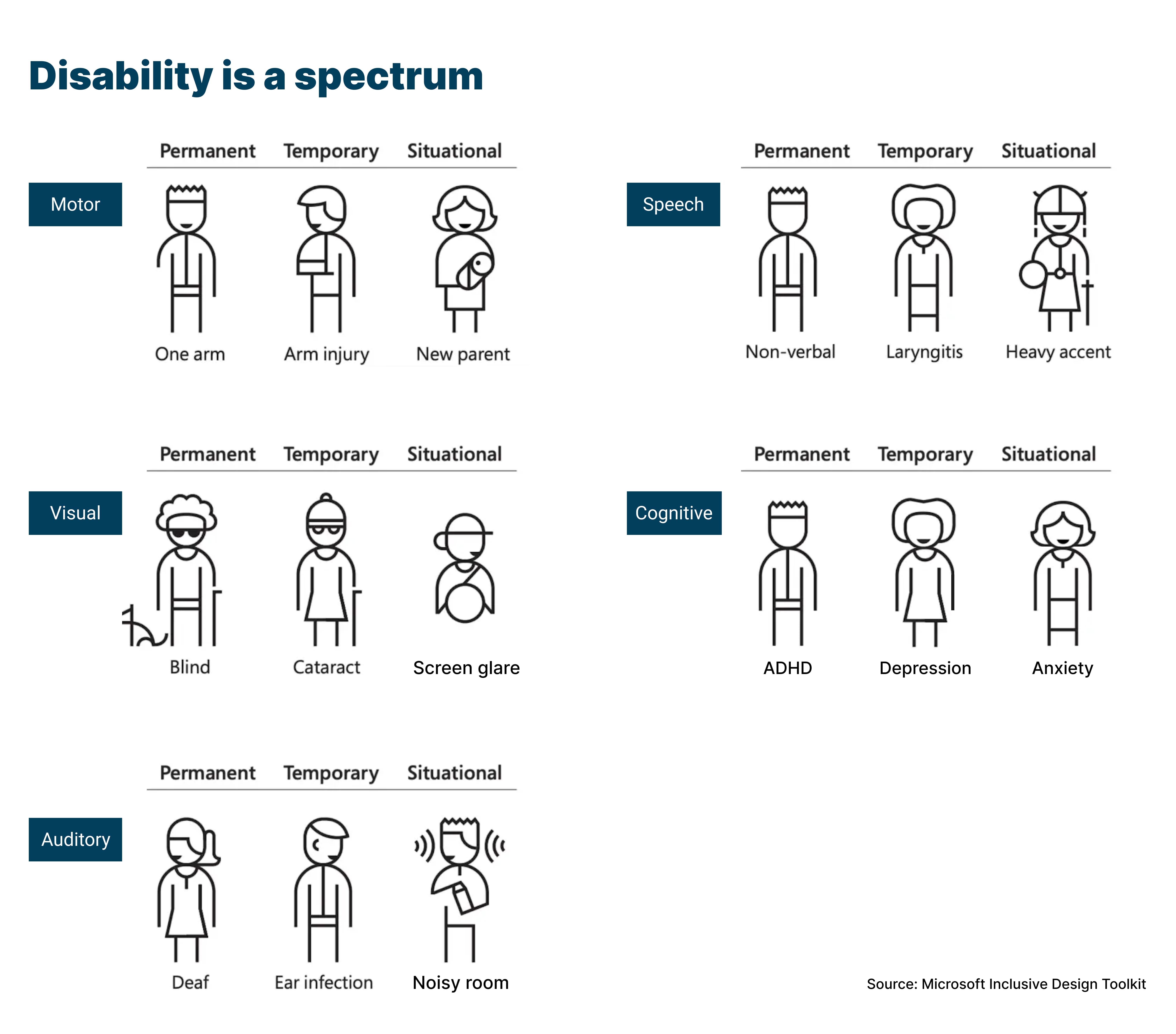In the UK, 1 in 5 people are disabled and 80% have a hidden disability* (source: Department for Work & Pensions, 2018/19).
*A hidden disability refers to disabilities that are not immediately apparent. It includes autism, mental health, acquired/traumatic brain injury, sensory processing, multiple sclerosis, epilepsy, partial sight and hearing loss.
People’s functional abilities exist on a spectrum, with a wide range of capabilities. Most of us experience disabilities that are temporary and situational on a daily basis.

These disabilities can be categorised into three:
- Permanent: Permanent disabilities will not change over a period of time and stay the same no matter the space or environment.
- Temporary: Temporary disabilities will change with time. For example a sport injury like broken fingers.
- Situational: Situational disabilities are not related to time, but rather particular scenarios. For example, you might be holding a toddler in another arm while trying to place an order on a website.
Accessibility is directed at people who have disabilities but accessibility benefits everyone. In fact, great design* is accessible! Think of how curb cuts were for people in wheelchairs but helped mothers with prams, bike riders and many others.
*Design refers to something that is or has been intentionally created by a thinking agent. A thinking agent is often referred to as a designer, i.e. someone who applies their creativity, problem-solving skills, and technical knowledge to create solutions that meet specific needs or objectives.
The current landscape
8 in 10 companies are now working to achieve digital accessibility, but only 36% have a top-down commitment to creating an accessible digital experience (source: Forrester, 2021).
There is a noticeable change in attitudes and commitment to delivering accessibility. Accessibility is moving from compliance to being an embedded differentiator.
Even without formal commitments from top management, grassroots accessibility efforts led by passionate teams or individual employees are taking place in 48% of companies.
Thinking about accessibility
In our industry, when we talk about accessibility, we often refer to the concept of whether a product or service can be used by everyone regardless of their abilities or disabilities and however they encounter it. However, 70% of people believe that digital accessibility only applies to website design (source: Userway).
Digital accessibility extends beyond mere website design. It encompasses the approach to designing and developing digital content and technology that caters to the needs of all users. To cultivate a culture of accessibility, it's imperative to grasp its holistic impact. We must broaden our perspective beyond digital accessibility, by considering aspects such as:
- Communication:
- Can people contact and receive support and service via different communication channels?
- Is the information clear, direct, and easy to understand (Plain English)?
- Can content and resources be accessed in multiple formats?
- Marketing:
- Do all marketing materials, including emails, trade shows, and ads, follow accessibility guidelines?
- Are the planning and promotion of events done with accessibility in mind, including access to venues?
- Management:
- Has accessibility been considered throughout every stage of a project so that team members will feel empowered and comfortable with their work?
- Are internal communications, such as emails, documents, and meetings, accessible?
- Are there accessible feedback channels where employees can report accessibility issues or suggest improvements?
- Human resources:
- How accessible and inclusive is your workplace?
- Have accessibility practices, such as the job description and interview, been considered?
- Are there employee resource groups to provide support, advocacy, and a platform for discussing accessibility issues?
We need to shift the mindset from a technical hurdle to a core value to ensure that no matter a person's abilities, they can interact and benefit from what's offered.
Accessibility in the workplace
Accessibility is not the responsibility of one person. Everyone, regardless of their team, is responsible for making a service accessible.
- Leadership teams
- Compliance and legal team
- Human resources team
- Marketing/Communication teams
- Design team
- Development team
This is why it’s best to consider employees from different departments to ensure a broad impact. Although accessibility is a team effort, it is important to define the role and responsibilities of each champion. Having a leader can help coordinate efforts.
Here are some steps to help you introduce accessibility champions:
1 - Identify potential champions:
- Passionate advocate: Look for someone who genuinely cares about accessibility and inclusion. Their enthusiasm will fuel their efforts.
- Eager learner: Identify individuals who have or are willing to develop skills in accessibility practices and principles.
- Tech-savvy: They should be comfortable with technology and how it can help to remove barriers.
- Communicator: They should be able to clearly explain accessibility issues and solutions in a way that both technical and non-technical people can understand.
- Team player: Collaboration is key. They should be able to work effectively with colleagues across departments.
2 - Define the champion’s role:
- Igniting a spark: Organise workshops, training sessions, and internal campaigns to get everyone on board with accessibility. Make it fun! Consider gamification, contests, or "accessibility awareness weeks" to keep everyone involved.
- Breaking down barriers: Collaborate with colleagues to identify and remove accessibility hurdles in physical spaces, digital products, and communication strategies.
- Building accessibility in: Integrate accessibility considerations from the very beginning (design & development) and throughout the entire lifecycle of services (including maintenance).
- Advocating change: Form a committee that can empower champions across departments to influence/inform decision-making processes and company policies.
- Expanding the Network: Connect with external accessibility communities. This will help foster knowledge sharing and learning from best practices outside the organisation.
3 - Empower the champions:
- Training and resources: Offer comprehensive training on accessibility standards (e.g., WCAG), tools, and best practices. Invite accessibility experts to share their knowledge. Encourage continuous learning and consider professional certifications in accessibility.
- Dedicated time: Give the champion dedicated time within their schedule to pursue accessibility initiatives.
- Leadership support: If stakeholders are on board with accessibility, public backing from leadership demonstrates the importance of accessibility. Allocate a budget for champion-related activities, not just for web projects.
4 - Measure and celebrate success:
- Set goals: Define clear, measurable goals for accessibility improvements within the organisation.
- Track progress: Use metrics and KPIs to track the progress of accessibility initiatives.
- Celebrate achievements: Publicly celebrate milestones and successes to maintain momentum and demonstrate the impact of accessibility efforts.
Parting thought
Ultimately, our goal is to make services and products as accessible as possible by removing barriers that make it impossible or difficult for anyone looking to access something. Don't just meet digital accessibility standards. Try to go beyond and embed accessibility in the workplace.
Remember:
- 100% accessibility does not exist!
- Accessibility is not a project or a one-time achievement, it’s a journey of continuous improvement.
- Even when you’ve made strides in accessibility, there’s always room to enhance and refine.
- Accessibility champions are the driving force behind creating a more inclusive world.
By adopting a mindset of continuous improvement, we ensure that accessibility remains a priority in all our endeavours, from the workplace to our products and services. Every small step contributes to making our society more inclusive for everyone.



